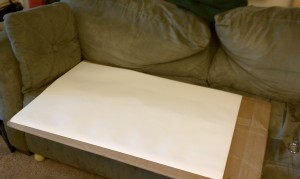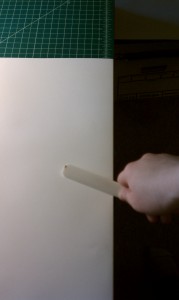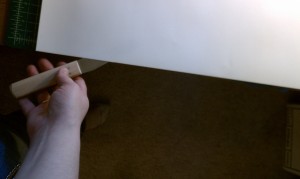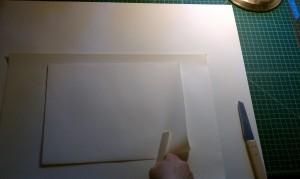One thing I absolutely adore about bookbinding work is getting to work with really good paper. I’ve always loved paper — I used to collect stationary and write lots of physical letters, and the feel of really high quality paper under my fingers has always been something that has a lot of appeal. I already knew that working with paper (like doing a collage) easily turns into a meditative, relaxing activity, but oh, man, when I get to work with really good paper? Best. Thing. Ever.
The paper I am currently smitten with, Mohawk Superfine 70lbs, pretty much only comes in parent sheets (which are enormous) or in 8.5″x11″ reams, which are pretty useless for the blank books I want to make. Thankfully, I learned how to tear down parent sheets in one of my bookbinding classes, and the San Francisco Center for The Book will rent out access to their workshop, so I went ahead and ordered a bunch of parent sheets. Check it out:

Those babies are 25″x38″. To get them into usable pieces, all you need is a bone folder and a good paper knife. I wound up enjoying the process so much that rather than just do a few and do the rest at the SFCB with one of their guillotines, I’ve been doing all of them — and that means hacking up almost 40 parent sheets into either eight sheets (for medium sized journals) or into 12 sheets (three for a large journal I’m making for myself and nine for little pocket notebooks). That’s a lot of cutting, but boy howdy, I’m really enjoying it! It works like this:



It takes a bit of care to slit right along the fold — it helps to line the fold up with the edge of the table and use the surface of the table beneath the paper to keep the knife flat, but you don’t want it to be totally flat, it needs to point up just a teensy bit or you wind up scalloping into the bottom side of the paper. It requires total attention, which is part of what makes it so enjoyable for me. I can’t get distracted by whatever I’m worried about or let my mind wander down some random avenue of thought or I’ll ruin the cut. A little scalloping isn’t a huge problem, since I’m going for a handmade look and anyway, some of these blank books will get trimmed on the huge book guillotine at the SFCB. But still, a perfectly straight cut makes the paper easier to work with and is a lot more satisfying.
I practice sitting meditation regularly, and can tell you from experience that it is a lot easier to enter a meditative state when you have something to focus on. Just sitting there, zazen-style, and trying to clear your mind and slow the chatter is really, really hard. It’s even harder when you’re exhausted or cranky or generally in need of a little meditative-style soothing! Something like a mantra or paying very close attention to your breathing (usually by counting each breath) can be really helpful, and it turns out that paper cutting is doing it for me — which is awesome, since it has an actual, tangible output!
Plus, the resulting page edges are lovely: soft, with an almost fuzzy or torn-looking edge, except they’re nice and straight (if I do them right, anyway). They remind me of old books I’ve read — my Mom’s cheap book club books from the fifties full of stories about The Saint. But they also remind me of books from a few centuries ago, when the pages didn’t get slit down until after they’d been bound. The parent sheets got printed on both sides and then folded up carefully to make each signature, and once the book had been bound the pages had to be slit apart. It was actually a special thing to slit the pages yourself, because it meant you bought the book brand new and nobody else had read it.
Regardless, I’m enjoying the process immensely. It’s not terribly efficient, but I’m doing it because it helps me unwind after a long day rather than to make money.